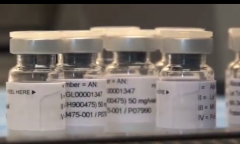By Prei Dy, | June 04, 2017

A new virtual reality technology is helping amputees deal with phantom limb pain. (YouTube)
A team of researchers has developed a new virtual reality technology that could relieve the sensation of phantom limb pain, described as pain felt in a limb that is no longer there.
The new technology, which is helping amputees, works by tricking the patient's brain into thinking that the missing limb still exists.
Like Us on Facebook
"The tactile representation of different body parts are arranged in the brain in a sort of map," Bo Geng from the Aalborg University in Denmark said. "If the brain no longer receives feedback from an area, it tries to reprogramme its signal reception map. That is the most common conception of how phantom limb pain occurs."
Several tests have previously revealed that phantom limb pain could be relieved if the brain is tricked into thinking that the amputated limb is still attached to the body. Placing a mirror at an angle in front of the chest could create a visual illusion that the body is symmetrical. If patients pretend to do the same movements simultaneously on both hands, the brain could be convinced that it still in control or in contact with the amputated body part.
The method has been proven effective to a number of amputees and has been used as the basis for the new VR technology, which aims to create a three dimensional world for the amputee.
"With virtual reality there is a much better chance of creating a convincing alternative reality," Geng said.
The new method will let amputated patients wear VR googles and a glove, while electrodes are placed on the residual limp, or stump. The stump is then stimulated by tiny electrical impulses to recreate the sensation of the phantom hand. The VR tech also offers several games that include the use of both hands.
"With this new method we try to overcome that conflict by providing an artificial visual and tactile feedback and in that way suppress the pain," she said.
The new system underwent its first clinical trial at the China Rehabilitation Center in 2016. So far, three patients responded positively. Two felt that their phantom limb pain was alleviated, while the third reported a decrease in the frequency of phantom limb pain attacks.
-
Use of Coronavirus Pandemic Drones Raises Privacy Concerns: Drones Spread Fear, Local Officials Say

-
Coronavirus Hampers The Delivery Of Lockheed Martin F-35 Stealth Fighters For 2020

-
Instagram Speeds Up Plans to Add Account Memorialization Feature Due to COVID-19 Deaths

-
NASA: Perseverance Plans to Bring 'Mars Rock' to Earth in 2031

-
600 Dead And 3,000 In The Hospital as Iranians Believed Drinking High-Concentrations of Alcohol Can Cure The Coronavirus

-
600 Dead And 3,000 In The Hospital as Iranians Believed Drinking High-Concentrations of Alcohol Can Cure The Coronavirus

-
COVID-19: Doctors, Nurses Use Virtual Reality to Learn New Skills in Treating Coronavirus Patients











